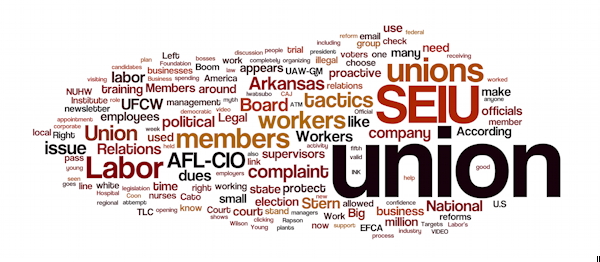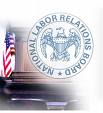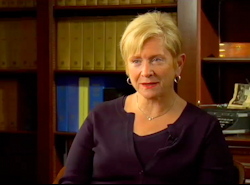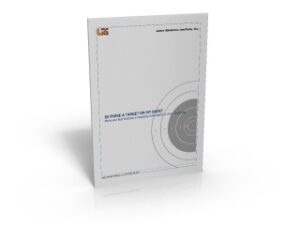 Labor Relations INK In This Issue: • EFCA Update • Big Win for Big Labor • Use The Big Stick! • SEIU Watch, Only In A Union, and more… Preview what is in this issue:
Labor Relations INK In This Issue: • EFCA Update • Big Win for Big Labor • Use The Big Stick! • SEIU Watch, Only In A Union, and more… Preview what is in this issue: 
Labor Relations Insight from Phil Wilson
Positive Employee Relations: Is Authentic Leadership Universal?  All positive employee relations environments require strong, authentic leaders. But is authentic leadership universal? Does it apply across different industries or even different cultures? Let’s say you’re a functional corporate director with a six-figure income and responsibility for a few million dollars of company business. Part of the people you oversee are hourly employees with high-school education working in one of the business units you oversee. How do you — who they might consider a “stuffed shirt” from corporate — effectively communicate with and coach them? We run into this situation all the time with our clients. I believe that being “authentic” is the master key to relating, communicating and coaching in the workplace, no matter the environment. Here are 3 tips I give on authentic leadership: 1. It starts with a mirror. While nobody I know thinks of themselves as a “stuffed shirt from corporate” I’ve seen plenty of executives who see themselves as smarter or better than the average production employee. These people forget that leadership isn’t something you get with a title or a degree – it happens when people choose to follow you. An authentic leader understands that if you aren’t getting the results you want you don’t blame the follower – you look yourself in the mirror and figure out what you are doing to contribute to the problem. Just that small change in mindset will transform your interactions with others. 2. Good leaders understand they have a toolbox with one tool – their conversations. If you are a leader you are no longer in a position to actually do the work. So your conversations are the only tool you have to accomplish your goals. If you can’t connect with others through your conversations you will fail. It is that simple. So a good leader understands that they need to master the art of getting results through conversations. The fastest way to do that is by connecting to others in an authentic way. People quickly figure out whether you are “real” and even if you have power over them you won’t have their full effort without an authentic relationship. 3. I believe authentic leadership is universal. I have international clients with operations in the US and it is interesting to watch leaders from other countries work here. The best ones learn to flex their style to work in a very different culture, and the ones who fail don’t flex. I’ve seen the same thing internationally (mainly in Canada) where American leaders fail when they don’t adapt. But in the end the ones who succeed are the ones who are authentic and use the power of their conversations to build relationships and ultimately followers in their organization. It is really important for leaders of any culture or background to be authentic. You can “fake it” for a while (although most people who think they are getting away by faking it usually are just fooling themselves). But to be successful long-term you must strive to have authentic, “real” relationships with coworkers — not just your immediate staff, but at all levels of the organization. ********** EFCA Update
All positive employee relations environments require strong, authentic leaders. But is authentic leadership universal? Does it apply across different industries or even different cultures? Let’s say you’re a functional corporate director with a six-figure income and responsibility for a few million dollars of company business. Part of the people you oversee are hourly employees with high-school education working in one of the business units you oversee. How do you — who they might consider a “stuffed shirt” from corporate — effectively communicate with and coach them? We run into this situation all the time with our clients. I believe that being “authentic” is the master key to relating, communicating and coaching in the workplace, no matter the environment. Here are 3 tips I give on authentic leadership: 1. It starts with a mirror. While nobody I know thinks of themselves as a “stuffed shirt from corporate” I’ve seen plenty of executives who see themselves as smarter or better than the average production employee. These people forget that leadership isn’t something you get with a title or a degree – it happens when people choose to follow you. An authentic leader understands that if you aren’t getting the results you want you don’t blame the follower – you look yourself in the mirror and figure out what you are doing to contribute to the problem. Just that small change in mindset will transform your interactions with others. 2. Good leaders understand they have a toolbox with one tool – their conversations. If you are a leader you are no longer in a position to actually do the work. So your conversations are the only tool you have to accomplish your goals. If you can’t connect with others through your conversations you will fail. It is that simple. So a good leader understands that they need to master the art of getting results through conversations. The fastest way to do that is by connecting to others in an authentic way. People quickly figure out whether you are “real” and even if you have power over them you won’t have their full effort without an authentic relationship. 3. I believe authentic leadership is universal. I have international clients with operations in the US and it is interesting to watch leaders from other countries work here. The best ones learn to flex their style to work in a very different culture, and the ones who fail don’t flex. I’ve seen the same thing internationally (mainly in Canada) where American leaders fail when they don’t adapt. But in the end the ones who succeed are the ones who are authentic and use the power of their conversations to build relationships and ultimately followers in their organization. It is really important for leaders of any culture or background to be authentic. You can “fake it” for a while (although most people who think they are getting away by faking it usually are just fooling themselves). But to be successful long-term you must strive to have authentic, “real” relationships with coworkers — not just your immediate staff, but at all levels of the organization. ********** EFCA Update  In the latest policy paper from the American Enterprise Institute, the calculators have been pulled out, and the potential damage to the US economy created by the implementation of the Employee Free Choice Act has been tallied. To quote the paper:
In the latest policy paper from the American Enterprise Institute, the calculators have been pulled out, and the potential damage to the US economy created by the implementation of the Employee Free Choice Act has been tallied. To quote the paper:
If the EFCA returns unionization rates to 1970s levels, it could reduce economy- wide employment and gross domestic product by close to 4 percent. This translates to about 4.5 million jobs lost and over $500 billion in lost output and income. Job loss resulting from EFCA will tend to fall disproportionately on workers with relatively low levels of education and skills. Ironically, these are the very workers the proposed legislation is intended to help.
 Even though the original bill will most likely not see the light of day as a single intact piece of legislation, the NRLB has begun to indicate in recent decisions that it is likely to incorporate much of the bill via rule-making. Trumka and other labor leaders have not given up hope that the main provisions of the EFCA could be incorporated into some other piece of legislation, making the changes to labor laws more permanent. Said Trumka, “Anything we can get it attached to. There are multitudes of things we can get it attached to, and we will. We will get it done and it will be a good thing for the country.” In a seemingly out-of-character move for a government agency, the board has even begun to publicize via press releases the results of union elections, attempting to flavor the media exposure of such activity. The entire orientation of the Department of Labor is moving in a new direction. As is evidenced by the recent announcement that it will discontinue providing Opinion Letters, the DOL is focusing on enforcement and prosecution of “violations,” rather than being a helpful resource to businesses attempting to navigate the swampland of government regulation. Beyond the DOL, the entire administration is tilted in favor of unions, and it seems that it is using almost every piece of legislation being discussed to contribute to the Big Labor cause. The latest example comes from the “financial reform” bill winding its way through Congress. As washingtontimes.com states:
Even though the original bill will most likely not see the light of day as a single intact piece of legislation, the NRLB has begun to indicate in recent decisions that it is likely to incorporate much of the bill via rule-making. Trumka and other labor leaders have not given up hope that the main provisions of the EFCA could be incorporated into some other piece of legislation, making the changes to labor laws more permanent. Said Trumka, “Anything we can get it attached to. There are multitudes of things we can get it attached to, and we will. We will get it done and it will be a good thing for the country.” In a seemingly out-of-character move for a government agency, the board has even begun to publicize via press releases the results of union elections, attempting to flavor the media exposure of such activity. The entire orientation of the Department of Labor is moving in a new direction. As is evidenced by the recent announcement that it will discontinue providing Opinion Letters, the DOL is focusing on enforcement and prosecution of “violations,” rather than being a helpful resource to businesses attempting to navigate the swampland of government regulation. Beyond the DOL, the entire administration is tilted in favor of unions, and it seems that it is using almost every piece of legislation being discussed to contribute to the Big Labor cause. The latest example comes from the “financial reform” bill winding its way through Congress. As washingtontimes.com states:
The end result will be a highly politicized process. Just look at how Mr. Dodd’s legislation gives the Securities and Exchange Commission the power to force names of outside nominees onto the corporate ballot for board of director positions. If there’s any doubt that such provisions are specifically designed to empower unions, one need only look to the way bondholder assets at General Motors and Chrysler were given to organized labor.
It doesn’t look like Big Labor will repeat the mistake it made during the first half or so of 2009, when it sat on its hands waiting for legislative help in organizing. The Communications Workers and the Electrical Workers are cranking up their door-to-door organizing routine, recently capturing a rare win at Comcast. ********** 12 Union Myths Exposed In our seventh installment of The Cato Journal’s January 2010 “Are unions good for America?” issue, we cover the seventh myth. Here is The Homeland Stupidity web site’s synopsis of this myth, and a link to each of the 12 Cato articles.
Myth Number Seven: Teachers’ unions work to increase the quality of children’s education. Fact: Teachers’ unions work to increase their membership rolls and their political power, at the expense of your children’s education. While collective bargaining has done little to increase the salaries of union public school teachers over nonunion public school teachers, these unions perform a different service for their members: preventing them from having to educate children. Andrew J. Coulson, director of the Center for Educational Freedom at the Cato Institute, explains that teachers’ unions strongly oppose government reforms which would improve the quality of K-12 education, such as charter schools, vouchers, and property tax credits.
Download the PDF here. Check out the Cato Journal and access all 12 PDFs here. ********** Big Win for Big Labor  The National Mediation Board, which oversees union elections in the rail and airline industries, just made it vastly easier for unions to organize those businesses. Rules were changed, so that instead of a majority of all voters needed to vote a union in, all that is now required is a majority of those who vote. **********
The National Mediation Board, which oversees union elections in the rail and airline industries, just made it vastly easier for unions to organize those businesses. Rules were changed, so that instead of a majority of all voters needed to vote a union in, all that is now required is a majority of those who vote. **********
Left of Boom: Best Practices for Proactive Companies in a Changing Labor Environment Some of the most powerful business tactics and strategies are discovered in the crucible of the war. Discover the new lessons for American businesses learned from the experiences of American troops in Iraq and Afghanistan. • Why most of your “proactive” measures aren’t proactive at all and how to tell the difference between real and “fake” preventive measures; • The 5 key tactics military strategists used when they realized they were losing against insurgent IED attacks – and how you can apply them in your business today; • 6 different “left of boom” activities you can use now that will give your company big leverage in its positive employee relations strategy.; Download your free copy of “Left of Boom” by clicking the link below: Click here to download your copy. ********** SEIU Watch
SEIU officially has a new head, Mary Kay Henry. One of Big Labor’s own media voices perhaps painted the picture least tainted by PR “bloat.”For her part, Mary Kay Henry has been rapidly accumulating plaudits that are similarly disconnected from reality, although widely disseminated by media outlets ranging from Politico to The New York Times to our very own In These Times. For example, it was actually suggested earlier this week, in the Times, that Henry is “someone fresh and new,” when in fact she is a quintessential product of the SEIU managerial class recruited and installed by Stern or his predecessor, John Sweeney, over the last 30 years.
As to her qualifications to represent “working people?” Again, quoting from Working In These Times:
Unlike Stern and Burger—but like a majority of those elevated to high positions by them—Henry has never been a working member of SEIU. She joined the union staff as a researcher in 1979. She managed to get on the IEB, as a Stern appointee, 17 years later without ever having been elected to any local union position—not shop steward, negotiator, e-board member, or president. She has never even run a local union as a Stern-appointed trustee (the usual path to upward mobility in SEIU for college-educated staffers hired from the outside).
So what should we expect from Mary Kay, and the SEIU? According to some of her recent statements: • SEIU will have 120,000 new members • $4 million will be allocated to organize sectors where union representation is weak, such as banks and grocery stores • She will not work to bring SEIU back into the AFL-CIO, which is at odds with recent statements by AFL-CIO head Trumka • SEIU will “expand” its political efforts in 2010 • SEIU will reverse the trend of the national leadership pushing policy down to the local level, and will instead provide more support to the locals • She will push to settle the dispute over jurisdiction and assets with UNITE HERE One unspoken agenda item will be working to stem the tide of workers attempting desperately to leave the SEIU for rival upstart, NUHW. Although the SEIU has attempted to block elections for more than 11,000 workers, and allow elections only when they feel they have a strong chance of winning, the election outcomes still keep falling to the side of the NUHW. What will Andy Stern do now that he is unemployed? Apparently, he will hit the speaking circuit to capitalize on his notoriety. According to a press release from his new agent, Leading Authorities,
Stern will be addressing audiences about politics and issues such as fiscal policy, entitlements, immigration, healthcare, and the future of the labor movement. He will speak independently, and also be matched with leading Republican thinkers.
Can’t wait! ********** IAM Organizers Get Nasty  Delta employees have apparently been harassed at their homes, incurring a voice message to the employees from CEO Richard Anderson directing them to call the cops for help if they feel threatened. Some employees have charged that organizers for the International Association of Machinists and Aerospace Workers have frightened their children and spouses, and even blocked driveways, not allowing residents to leave their homes. “Conduct like this is harassment. It’s wrong,” Anderson said. “This is not how we treat people at Delta.” IAM officials deny the charge (of course). When Northwest Airlines was acquired by Delta in a 2008 merger, IAM organizers were energized to attempt to bring the Delta ground workers and flight attendants into the union fold. Similar employees had been unionized at Northwest, but not at Delta. IAM organizers were just handed a major helping hand in their efforts by the recent National Mediation Board rule changes. ********** LRI’s Latest Interview with an Organizer Video
Delta employees have apparently been harassed at their homes, incurring a voice message to the employees from CEO Richard Anderson directing them to call the cops for help if they feel threatened. Some employees have charged that organizers for the International Association of Machinists and Aerospace Workers have frightened their children and spouses, and even blocked driveways, not allowing residents to leave their homes. “Conduct like this is harassment. It’s wrong,” Anderson said. “This is not how we treat people at Delta.” IAM officials deny the charge (of course). When Northwest Airlines was acquired by Delta in a 2008 merger, IAM organizers were energized to attempt to bring the Delta ground workers and flight attendants into the union fold. Similar employees had been unionized at Northwest, but not at Delta. IAM organizers were just handed a major helping hand in their efforts by the recent National Mediation Board rule changes. ********** LRI’s Latest Interview with an Organizer Video  Mary Holden worked in the grocery industry in the upper Midwest, first as an employee and UFCW shop steward, and later as a human resources manager. Mary has seen the union’s hidden agenda from both sides of the bargaining table. For a compelling, fresh story of the real union agenda, check out our latest organizer interview here (viewing requires a username and password – to request one call 800-888-9115 or fill out the password request form). ********** Inconvenient History
Mary Holden worked in the grocery industry in the upper Midwest, first as an employee and UFCW shop steward, and later as a human resources manager. Mary has seen the union’s hidden agenda from both sides of the bargaining table. For a compelling, fresh story of the real union agenda, check out our latest organizer interview here (viewing requires a username and password – to request one call 800-888-9115 or fill out the password request form). ********** Inconvenient History  Historian and author Thomas E. Woods, Jr., recently released an editorial on the history of the labor movement. Occasionally, it helps to go back to root issues, so as not to become trapped in fallacious arguments founded on false pretext. We thought it beneficial to quote from the article at length, but I encourage you to read the entire piece.
Historian and author Thomas E. Woods, Jr., recently released an editorial on the history of the labor movement. Occasionally, it helps to go back to root issues, so as not to become trapped in fallacious arguments founded on false pretext. We thought it beneficial to quote from the article at length, but I encourage you to read the entire piece.
The standard tale that practically every student hears over the course of his education is that before the emergence of labor unions, American workers were terribly exploited and their wages were consistently falling. The improvement in labor’s condition was due entirely or at least in large part to labor unionism and favorable federal legislation. In the absence of these, it is widely assumed, people would still be working 80-hour weeks and children would still be working in mines. This oft-heard tale is, however, almost entirely false, and those parts of it that are true (the low standard of living that people enjoyed in the nineteenth century, for example) are true for reasons other than those alleged by pro-union historians, who see in them only confirmation of their prejudices against the market economy.
Woods describes how the Norris-La Guardia Act of 1932 exempted unions from the Sherman Antitrust act, therefore also exempting them from behavior that law deemed criminal in any other context! After describing the impact of the Wagner Act in 1935, he quotes Harvard University’s Edward Chamberlin’s attempt to describe the unique legal status that labor unions had been granted by the law:
If A is bargaining with B over the sale of his house, and if A were given the privileges of a modern labor union, he would be able (1) to conspire with all other owners of houses not to make any alternative offer to B, using violence or the threat of violence if necessary to prevent them, (2) to deprive B himself of access to any alternative offers, (3) to surround the house of B and cut off all deliveries, including food (except by parcel post), (4) to stop all movement from B’s house, so that if he were for instance a doctor he could not sell his services and make a living, and (5) to institute a boycott of B’s business. All of these privileges, if he were capable of carrying them out, would no doubt strengthen A’s position. But they would not be regarded by anyone as part of “bargaining” – unless A were a labor union.
Nobel Laureate F.A. Hayek chimed in on this state of affairs, “We have now reached a state where [unions] have become uniquely privileged institutions to which the general rules of law do not apply.” Addressing the impact of the collective body of labor law, Woods states,
The ways in which labor unionism impoverishes society are legion, from the distortions in the labor market described above to union work rules that discourage efficiency and innovation. The damage that unions have inflicted on the economy in recent American history is actually far greater than anyone might guess. In a study published jointly in late 2002 by the National Legal and Policy Center and the John M. Olin Institute for Employment Practice and Policy, economists Richard Vedder and Lowell Gallaway of Ohio University calculated that labor unions have cost the American economy a whopping $50 trillion over the past 50 years alone.
Unionist arguments are based on unsound economic reasoning, the kind of short-sightedness famed economic journalist Henry Hazlitt addressed in “Economics In One Lesson.” Woods adds to the debunking of union arguments,
The case for labor unionism does possess a superficial plausibility, but it is in fact entirely fallacious. Real wages rise not because of union activity but because of the process that George Reisman describes in his productivity theory of wages… In short, business investment in machinery increases the productivity of labor and therefore the output that the economy is capable of producing, and this greater supply puts downward pressure on prices. As Reisman explains, “It is the productivity of labor that determines the supply of consumers’ goods relative to the supply of labor, and thus the prices of consumers’ goods relative to wage rates.” This phenomenon is not always easy to see in an inflationary economy such as ours, in which prices of most goods seem to go up consistently. But the point remains: prices become lower than they would otherwise be, and all real incomes (wages included) increase.
Woods concludes,
The vast bulk of the existing scholarship on American labor history is essentially unreadable. It takes for granted all the economic myths of unionism, the essential righteousness of the union cause, and the moral perversity of anyone who would dare to oppose it… Labor historians and activists would doubtless be at a loss to explain why, at a time when unionism was numerically negligible (a whopping three percent of the American labor force was unionized by 1900) and federal regulation all but nonexistent, real wages in manufacturing climbed an incredible 50 percent in the United States from 1860–1890, and another 37 percent from 1890 to 1914, or why American workers were so much better off than their much more heavily unionized counterparts in Europe. Most of them seem to cope with these inconvenient facts by neglecting to mention them at all.
I suppose the truth can be a bit inconvenient. ********** Big Labor Fights To Protect Bad Nurses  The California Nurses Association (now folded into the United American Nurses super-union) continually promotes mandated nurse/patient ratios based almost solely on the argument that it is in the best interests of the patient. Unfortunately, it is quite obvious that patient care is far from the list of foremost concerns of the nurses union, or any other union for that matter. The Chamber of Commerce neatly sums up the latest travesty perpetrated upon the California public by Big Labor:
The California Nurses Association (now folded into the United American Nurses super-union) continually promotes mandated nurse/patient ratios based almost solely on the argument that it is in the best interests of the patient. Unfortunately, it is quite obvious that patient care is far from the list of foremost concerns of the nurses union, or any other union for that matter. The Chamber of Commerce neatly sums up the latest travesty perpetrated upon the California public by Big Labor:
ProPublica and the L.A. Times have published the results of a joint investigation into the failed oversight of California’s health professionals, finding underfunding, omitted criminal background checks, failure to monitor those placed on probation and even failure to act against nurses whose egregious misconduct had already been thoroughly documented and sanctioned by other government agencies, including loss of licenses by other states. While the system failed, many with sordid pasts continued working for years, continuing to hurt trusting patients, because their Board of Registered Nursing records remained spotless. California employers are not required to report nurses guilty of malfeasance and the state lacks the tools to track those nurses who violate the public trust. Governor Schwarzenegger was so distraught that he sacked the entire Board. The new Board began fingerprint screening, discovering registered nurses who had been convicted of murder, sex offenses, robbery and assault. Schwarzenegger reached across the aisle and asked a democratic State Senator to carry a bill, SB 1111, to remedy the situation. Primarily, it simply extends to nurses, dentists, pharmacists, psychologists, optometrists, chiropractors and veterinarians the same patient protections and disclosure provisions that have long been in place for doctors.
The SEIU and the nurses unions in the state are fighting fiercely to oppose the bill. The nurses unions are also up in arms about the implementation of Health Information Technology. Rather than using the latest technological advances to increase patient care, they are afraid of losing union dues-paying members. According to this 24-page document put out by the CNA-NNOC in 2009, “healthcare IT is driven by the desire of employers to control workers, that EMRs are used to spy on employees, and that technology is intended to homogenize health professionals and patients like interchangeable machine parts.” In yet another struggle against modernization in the face of validated test programs, nurses unions in California are opposing a pilot program in the state for “universal beds.” The concept is that rather than moving a patient from room to room – or sometimes even from floor to floor – as their conditions warrant, the rooms are adaptable to the conditions and needs of the patient. Where this has been tested elsewhere, the results have been strongly positive. The CNA is, of course, against the pilot program. Protecting criminals and bad nurses, avoiding the implementation of the best possible technology, and refuting the results of new best-practices – I can only imagine what our healthcare will look like as government and unions continue to collude to take over more of our system. ********** Use The Big Stick!  Bemoaning the fact that there were only 5 strikes last year of 1000 workers or more (and 3 of those were public union strikes), labor editorialist Joe Burns is calling on unions to man-up, and invoke one of its most powerful weapons. Harkening back to the nostalgic 1970s, when there were over 200 major strikes per year, Burns calls on Big Labor to look beyond the current emphasis of corporate campaigns and political machinations,
Bemoaning the fact that there were only 5 strikes last year of 1000 workers or more (and 3 of those were public union strikes), labor editorialist Joe Burns is calling on unions to man-up, and invoke one of its most powerful weapons. Harkening back to the nostalgic 1970s, when there were over 200 major strikes per year, Burns calls on Big Labor to look beyond the current emphasis of corporate campaigns and political machinations,
We’ve done 20 years of corporate campaigns. Absent strikes that stop business as usual, they will never hit employers hard enough to fundamentally alter the relationship between workers and bosses. Unionism must be based on power and in particular the power to force a different distribution of wealth in society. Unionists need a new approach. Labor law reform is stalled, public employees are under attack, and, while unions must organize or die, an organizing strategy alone has proved incapable of reviving the movement. To attract workers, unions must have the economic tools to improve their lives. The alternative path to union growth is developing a grassroots, fighting labor movement—the one strategy proven capable of producing major gains for working people and attracting massive waves of new members.
Burns concludes,
But after decades of declining membership, we must begin a discussion of the fundamentals of union power. When the labor movement rises up again as a powerful force in the United States, it won’t be as a result of legislation or of cutting deals with employers. It will be because workers have taken back their most powerful weapons—solidarity and halting production.
If Big Labor continues to make headway in the political arena, our bet is we’ll see an uptick in all types of “union persuasion,” including strikes, corporate campaigns and shareholder actions among others. ********** Do As I Say, Not As I Do Big labor continues to talk out of both sides of its mouth. On the one hand, they are cheering on new federal laws designed to eliminate the concept of internships within corporate America. At the same time, they are aggressively advertising to fill un-paid internships to aid in their organizing. To quote from the ad, “Our ground-up model of organizing and our comprehensive corporate campaigns are largely worker and volunteer run.” In this current economic crisis, it is more important than ever for committed local activists to get involved in the fight for workers’ rights. We have interviewed many former union staff and organizers, and know how well they are paid – often receiving compensation packages multiple-times larger than those of the employees they are attempting to organize. Guess they can continue to afford these extravagant packages when they can get people to work for free! ********** Only in a Union  Here’s the scenario: union includes a requirement in its collective-bargaining agreement that employees must report safety hazards. So, Joe union member follows the contract, and reports such a safety violation to his employer. What happens next? The union fines Joe member $2500! The NLRB charged the IUOE Local with a violation of the Nation Labor Relations Act. In Tacoma, WA, parents attempting to help out their local school were told not to proceed with some volunteer landscaping work. The reason, of course, is that the union complained that the contribution from parents would take away union work! First it was Boy Scout projects, now it is proud parents. Better be careful if you decide to pick up a piece of trash in a public park – you’re liable to find yourself fighting a lawsuit! ********** Sticky Fingers! Current charges or sentences of embezzling union officials: Thomas Renkes- ANA: $22,000 Truong Nguyen- IAFF: $46,000 Cory Carroll- BLE: $35,000 ********** Labor Relations INK is published semi-monthly and is edited by Labor Relations Institute, Inc. Feel free to pass this newsletter on to anyone you think might enjoy it. New subscribers can sign up by visiting: https://lrionline.com/free-stuff/newsletter-signup/ If you use content from this newsletter please attribute it to Labor Relations Institute and include our website address: www.LRIonline.com Contributing editors for this issue: Phillip Wilson, Greg Kittinger, Shaun Fanning You are receiving this email because you subscribed to receive our labor relations newsletters and updates. You can manage your email preferences by clicking the link at the bottom of any of our email communications. NOTE: if you are using Internet Explorer v. 6, read the text version, as the html will not load properly in IE6. We recommend upgrading to IE7.
Here’s the scenario: union includes a requirement in its collective-bargaining agreement that employees must report safety hazards. So, Joe union member follows the contract, and reports such a safety violation to his employer. What happens next? The union fines Joe member $2500! The NLRB charged the IUOE Local with a violation of the Nation Labor Relations Act. In Tacoma, WA, parents attempting to help out their local school were told not to proceed with some volunteer landscaping work. The reason, of course, is that the union complained that the contribution from parents would take away union work! First it was Boy Scout projects, now it is proud parents. Better be careful if you decide to pick up a piece of trash in a public park – you’re liable to find yourself fighting a lawsuit! ********** Sticky Fingers! Current charges or sentences of embezzling union officials: Thomas Renkes- ANA: $22,000 Truong Nguyen- IAFF: $46,000 Cory Carroll- BLE: $35,000 ********** Labor Relations INK is published semi-monthly and is edited by Labor Relations Institute, Inc. Feel free to pass this newsletter on to anyone you think might enjoy it. New subscribers can sign up by visiting: https://lrionline.com/free-stuff/newsletter-signup/ If you use content from this newsletter please attribute it to Labor Relations Institute and include our website address: www.LRIonline.com Contributing editors for this issue: Phillip Wilson, Greg Kittinger, Shaun Fanning You are receiving this email because you subscribed to receive our labor relations newsletters and updates. You can manage your email preferences by clicking the link at the bottom of any of our email communications. NOTE: if you are using Internet Explorer v. 6, read the text version, as the html will not load properly in IE6. We recommend upgrading to IE7.






